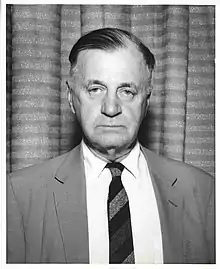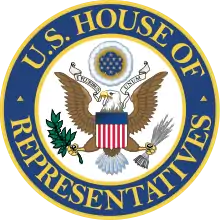Michael J. Kirwan
Michael Joseph Kirwan (December 2, 1886 – July 27, 1970) was a United States Democrat from Ohio who served as a Representative to the United States Congress for the 19th electoral district of Ohio from 1937 until his death in 1970 in Bethesda, Maryland, which resulted from complications related to a fall. At the peak of his long congressional career, Kirwan was hailed as one of the most influential Democratic members of Congress, particularly on matters related to conservation.[1]
Michael Joseph Kirwan | |
|---|---|
 | |
| Member of the U.S. House of Representatives from Ohio's 19th district | |
| In office January 3, 1937 – July 27, 1970 | |
| Preceded by | John G. Cooper |
| Succeeded by | Charles J. Carney |
| Personal details | |
| Born | December 2, 1886 Wilkes-Barre, Pennsylvania |
| Died | July 27, 1970 (aged 83) Bethesda, Maryland |
| Political party | Democratic |
| Wikimedia Commons has media related to Michael J. Kirwan. |
Early years
Mike Kirwan was born in Wilkes-Barre, Luzerne County, Pennsylvania, a manufacturing town in northeastern Pennsylvania.[2] In 1907, he relocated to Youngstown, Ohio, a center of steel production located just west of the Pennsylvania border. During the First World War Kirwan served overseas as a sergeant in the Three Hundred and Forty-eighth Machine Gun Company with the Sixty-fourth Artillery, United States Army. Records indicate he served between 1917 and 1919.[2] Kirwan was married to Alice Kane. They had three children, John, Michael and Mary Alice.
Political career
Upon his return to Youngstown, Kirwan established himself as an outspoken proponent of a plan to construct a Lake Erie to Ohio River canal – a proposal for which he would lobby tirelessly as Congressman from the 19th Congressional District of Ohio.[3] Despite his later occupancy of important committee positions, however, Kirwan was unsuccessful in his efforts to achieve his most cherished goal as a lawmaker.[3] Kirwin served on the Youngstown City Council from 1932 to 1936.[2]
Throughout the 1930s and early 1940s, Kirwan was successful in garnering substantial federal support for a variety of public works projects including dams, reservoirs, public swimming pools, and public park facilities. In 1940, he also helped to secure government funding for the nation's first major housing project, Westlakes Housing Village (later known as Westlakes Terrace), which was situated west of downtown Youngstown.[4] The housing project comprised 618 units capable of sheltering 2,500 people. Erected under government financing, the project received 90 percent of its funding ($2,862,000) on a 60-year loan basis. Upon its completion, Kirwan lauded the housing project as a welcome alternative to what had been a dilapidated residential district, and further declared that it would serve as a model for the nation.[4]
In later years, Westlakes Terrace, like other low-income housing projects, yielded mixed results. The provision of cheap housing proved to be inadequate compensation for the loss of thousands of urban jobs, the decline of public transportation, the advent of suburbanization, and a host of other trends that adversely affected urban dwellers. Westlakes Terrace was recently converted to other purposes.
Powerful testimony to Kirwan's growing influence in the U.S. Congress came in 1948, when he was unanimously elected chairman of the National Democratic Congressional Campaign Committee, the first time a Northern Democrat had been named to that important post.[5] In 1954, Kirwan was widely credited among Democratic Congressional leaders as the architect of the party's success in the November congressional elections.[6] Despite his advancing years, he announced on December 3, 1957 (his 71st birthday) that he would seek a 12th term in Congress.[7] The following year, Kirwan was among scores of Mahoning Valley Democratic candidates who secured sweeping victories; and in 1959, he was elected to his seventh term as chairman of the Democratic Congressional Campaign Committee.[8]
Final years
Among the highlights of Kirwan's later career was an event held in his honor at Youngstown's Idora Park Ballroom. The keynote speaker at that event was U.S. Senator John F. Kennedy, who would run successfully as the Democratic presidential candidate the following year.[8] In 1968, after being elected to his 17th term as a congressman, Kirwan announced that he would retire from public office at the close of his term.[9] The following year, he was injured in a fall at the University Club at Washington, D.C., and was confined to Bethesda Naval Hospital.[10] Kirwan experienced failing health for the next several months and died in Bethesda in 1970.[11] His funeral was attended by more than 600 people, including a delegation of 50 members of Congress.[11] He is buried at Calvary Cemetery, in Youngstown, Ohio.[2]
Legacy
While aspects of Kirwan's legacy have proved durable, the constituency he served was adversely affected by deindustrialization, which swept through much of northeastern Ohio starting in the late 1970s.
The primary educational television station in American Samoa bears Kirwan's name.[12]
Kirwan was often an outspoken critic of the expansion of the Gettysburg National Military Park by way of U.S. Interior Department spending. He was once quoted as saying, "We have enough land at Gettysburg. There is no use taking any more."[13]
Kirwan's papers are archived at Youngstown State University's Maag Library Archives and Special Collections.
The Michael J. Kirwan Reservoir impounds the west branch of the Mahoning River in Portage County, Ohio.[14]
Election results
| Year | Democratic | Republican | Other |
|---|---|---|---|
| 1968 | Michael J. Kirwan: 101,813 | Donald J. Lewis: 44,363 | |
| 1966 | Michael J. Kirwan: 86,975 | Donald J. Lewis: 34,037 | |
| 1964 | Michael J. Kirwan: 111,682 | Albert James: 34,654 | |
| 1962 | Michael J. Kirwan: 75,967 | William Vincent Williams: 46,200 | |
| 1960 | Michael J. Kirwan: 102,874 | Paul E. Stevens: 46,537 | |
| 1958 | Michael J. Kirwan: 93,660 | Loren E. Van Brocklin: 31,192 | |
| 1956 | Michael J. Kirwan: 92,924 | Ralph E. Turner: 42,293 | |
| 1954 | Michael J. Kirwan: 81,304 | David S. Edwards: 33,352 | |
| 1952 | Michael J. Kirwan: 91,074 | Allen Russell: 46,202 | |
| 1950 | Michael J. Kirwan: 119,245 | Henry P. Kosling: 67,661 | |
| 1948 | Michael J. Kirwan: 134,408 | William Bacon: 63,079 | |
| 1946 | Michael J. Kirwan: 88,872 | Norman W. Adams: 59,607 | |
| 1944 | Michael J. Kirwan: 120,191 | Herschel Hunt: 69,403 | |
| 1942 | Michael J. Kirwan: 60,248 | James T. Begg: 46,567 | |
| 1940 | Michael J. Kirwan: 122,075 | Charles H. Anderson: 75,016 | |
| 1938 | Michael J. Kirwan: 76,268 | William P. Barnum: 69,214 |
Notes
- Aley (1975), p. 446.
- "Congressional Biography". Biographical Directory of the U.S. Congress. Retrieved 2007-03-07.
- Aley (1975), p. 218.
- Aley (1975), p. 372.
- Aley (1975), p. 413.
- Aley (1975), p. 437.
- Aley (1975), p. 445.
- Aley (1975), p. 449.
- Aley (1975), p. 488.
- Aley (1975), p. 497.
- Aley (1975), p. 506.
- "Weekly Highlight 11/13/2009 Michael J. Kirwan Educational Television Center, Tutuila Island, Western, American Samoa".
- "Gettysburg Times" March 17, 1959
- Geographic Names Information System. "GNIS entry for Michael J. Kirwan Reservoir (Feature ID #1061227)". Retrieved 2016-04-11.
References
- Aley, Howard C. (1975). A Heritage to Share: The Bicentennial History of Youngstown and the Mahoning Valley. Youngstown, OH: The Bicentennial Commission of Youngstown and Mahoning County.
External links
- United States Congress. "Michael J. Kirwan (id: K000244)". Biographical Directory of the United States Congress.
- Kirwan Interview Notes
- Michael J. Kirwan Dam and Reservoir
- Election Results, U.S. Representative from Ohio, 19th District
| U.S. House of Representatives | ||
|---|---|---|
| Preceded by John G. Cooper |
Member of the U.S. House of Representatives from Ohio's 19th congressional district 1937–1970 |
Succeeded by Charles J. Carney |
